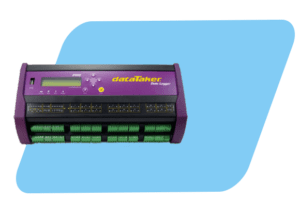Preventing Temperature Fluctuations For Refrigerated Products
CAS DataLoggers recently helped a frozen food manufacturer monitor current/voltage on several large 3-phase compressor motors used for refrigeration. As these compressors aged, valve leakage and piston ring deterioration resulted in cooler temperature fluctuations, which endangered product quality. The compressors often had to run at high loads to maintain a low evaporator coil temperature, and their effectiveness could be further strained by low line voltage conditions. To avoid compressor failure and realize energy savings, the manufacturer needed a compressor monitoring system with analog inputs that could monitor temperature at multiple points. They also needed suction and discharge pressure, with the ability to capture the equipment’s current/voltage/energy usage via a power meter to see how hard the compressors were working. In addition to recording the periodic measurements, the customer also needed to totalize the energy data and the motor on/off times requiring a device with onboard intelligence.
 The plant manager installed a dataTaker DT85 data logger in an industrial enclosure secured onto a pushcart, which allowed it to be moved around the factory to test the different compressors. Thermocouples were placed on the motors, compressors, condenser, and evaporator coils and then connected to the logger’s analog inputs. Additionally, 2 pressure transducers were connected to the refrigerant lines, one on the suction side and one on the discharge side. A WattNode WND-WR-MB power meter was connected to the compressor motor to monitor the current, voltage, and power and sent data to the logger via a Modbus RS485 interface.
The plant manager installed a dataTaker DT85 data logger in an industrial enclosure secured onto a pushcart, which allowed it to be moved around the factory to test the different compressors. Thermocouples were placed on the motors, compressors, condenser, and evaporator coils and then connected to the logger’s analog inputs. Additionally, 2 pressure transducers were connected to the refrigerant lines, one on the suction side and one on the discharge side. A WattNode WND-WR-MB power meter was connected to the compressor motor to monitor the current, voltage, and power and sent data to the logger via a Modbus RS485 interface.
The dataTaker DT85 intelligent data logger supported many communication features, including a USB memory stick port for data transfer, Modbus communications for SCADA systems, FTP for automated data upload, and a 12VDC regulated output to power sensors. The DT85 offered a flexible solution for monitoring all the required values. In addition, the dataTaker’s built-in logic and math functions allowed it to be programmed to calculate motor run time and other important parameters.
The DT85’s 16 analog input channels allow 16, 4 wire sensor inputs for sensors like strain gauges or up to 32 isolated or 48 commonly referenced, 2-wire analog inputs. These inputs can be used in many combinations and support a wide variety of sensor types. The logger can store up to 10 million data points in internal memory allowing weeks or months’ worth of data to be stored locally. Users could also easily copy it to a USB stick or automatically send it to a server via FTP.
Along with the logger and sensors, CAS also provided value-added services including technical support to help the customer use the loggers to calculate the total compressor energy consumed and run times. Using the internal channel variables and calculation capabilities of the dataTaker, it was simple to capture cumulative totals as well as to total over a particular period of time. Users could accumulate these totals since the start of the program or view a daily, weekly, or monthly total. In these cases, a schedule within the logger could be used to periodically reset the total.
 For example, if only a daily total was required, a second schedule could be created to run once a day, for example at one minute after midnight, and within this schedule variable containing the accumulated total could be reset to 0. For other reset intervals, the data logger also provides an internal value for the hour of the day, the day of the week, the day of the month, and the day of the year. Any of these can be used as a trigger in computing the totalized data.
For example, if only a daily total was required, a second schedule could be created to run once a day, for example at one minute after midnight, and within this schedule variable containing the accumulated total could be reset to 0. For other reset intervals, the data logger also provides an internal value for the hour of the day, the day of the week, the day of the month, and the day of the year. Any of these can be used as a trigger in computing the totalized data.
The dataTaker served as a single compressor monitoring solution for monitoring the customer’s 3-phase compressor motors and served as an early detection system before the compressors could fail. The data logger’s universal analog inputs are connected to all the needed sensors to give users the total picture of their machine data, and the dataTaker’s Modbus capability allowed connection to the WattNode Modbus sensor. The DT85 logger was also useful for identifying equipment and power issues. The dataTaker had additional uses whenever the business had to retrofit its motors and compare energy usage before and after replacement to get accurate before and after pictures of the cost savings.
For more info on the dataTaker DT85 data loggers, or to find the ideal device for your application-specific needs, contact a CAS Data Logger Applications Analyst at (800) 956-4437 or request more information.

